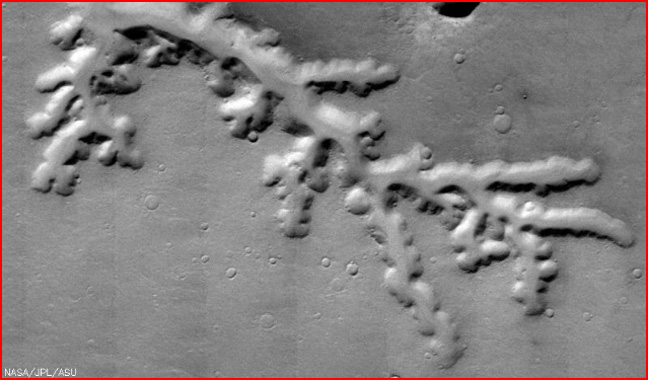|
|
||
 Credit: NASA/JPL/Arizona State University |
||
|
pic of the day Links:
Society for
|
Aug 18, 2004 Professional and amateur astronomers have long been fascinated by the valleys and canyons (also called “rilles”) on the surface of Mars. But one fact never mentioned is that the Martian rilles bare striking resemblance to lightning scars here on Earth. Ever since spacecraft have sent us close-up pictures of Mars, professional and amateur astronomers have been fascinated by the valleys and canyons (also called rilles) of this presently water-poor world. Could these rilles have been eroded in a previous age of more abundant water? Water erosion may seem to explain some, but others end in "high ground" at both ends--no drainage. Were these the work of parallel earthquake faults? Or sinkholes in series? In the 1960's, electrical engineer Ralph Juergens suggested another explanation for rilles. He pointed out the similarities between the rilles on neighboring worlds and lightning scars on Earth. Could electric discharge, on a scale much larger than we observe today, have carved the rilles? Craters, too, can be created by lightning and electric discharge. The rille in the THEMIS image above is a transition between crater chains and the more common form of rilles. This rille appears to be entirely composed of overlapping craters, which give the edges a more scalloped appearance than usual. Each of the many subchannels begins (or ends) with a rounded crater. The overlap of craters along the main channel of the rille and along its branches varies a great deal. In some places the overlap is so tight that only a hint of scalloping has been preserved. In other places nearly intact craters protrude like Mickey Mouse ears from the main channel. Along the rim of the channel, you can also see normal craters with no connection to the rille. These were created when the rille-forming arc began a new crater, but quenched before it could connect that crater to the main channel. Along many rilles, there are so many craters on or near the rim of the rille that "counting craters" in order to date the region produces a contradiction. The edges of the rille appear older than the surrounding surface. Channels like this are a strong argument against the accepted notion that most craters are formed by impact. See TPOD for Aug 11, 2004 Etched Mars and Water on Mars |
|
|
Copyright 2004: thunderbolts.info |
||
